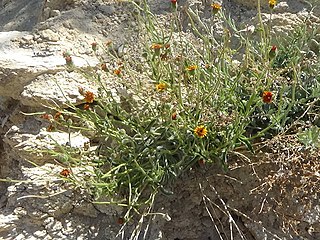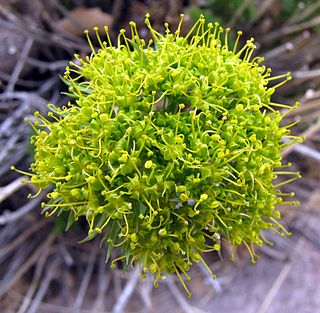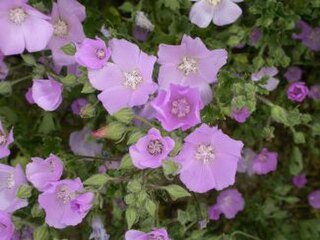
Agave parryi, known as Parry's agave or mescal agave, is a flowering plant in the family Asparagaceae, subfamily Agavoideae. It is a slow-growing succulent perennial native to Arizona, New Mexico, and northern Mexico.

Nolina parryi is a flowering plant that is native to Baja California, southern California and Arizona.

Eremalche rotundifolia, the desert five-spot, is a flowering plant in the family Malvaceae, native to the Mojave Desert and Colorado Desert in the Southwestern United States.
Sphaeralcea incana, with the common names gray globemallow and soft globemallow, is a desert plant in the mallow family (Malvaceae).

Penstemon parryi, the Parry's penstemon, Parry's beardtongue or desert penstemon, is a wildflower native to the Sonoran Desert of Southern Arizona and northern Mexico. It is a perennial that blooms in March and April. In the wild, plants flower in their second year. In cultivation, flowering is often achieved in the first year if seed is planted in the autumn.

Hulsea vestita is a species of flowering plant in the family Asteraceae known by the common name pumice alpinegold.

Jepsonia parryi is an uncommon species of flowering plant in the saxifrage family known by the common names coast jepsonia and Parry's jepsonia. It is a small geophytic plant that flowers briefly during fall, and often only has a single leaf that may appear above the ground after or during flowering. It is native to the coast and inland hills chaparral of southern California and Baja California.

Chorizanthe parryi is a species of flowering plant in the buckwheat family known by the common name Parry's spineflower and San Bernardino spineflower.

Lomatium parryi, commonly known as Parry's biscuitroot and Utah desertparsley, is a perennial herb in the carrot family. It is a common herb in high altitude areas of deserts and common in desert National parks, such as Death Valley mountains, in the western part of the United States.

Eremalche parryi is a species of flowering plant in the mallow family known by the common name Parry's mallow.

Sidalcea malviflora is a species of flowering plant in the mallow family, known by the common names dwarf checkerbloom, Greek mallow, prairie mallow and dwarf checkermallow.
Stephanomeria parryi is a species of flowering plant in the family Asteraceae known by the common name Parry's wirelettuce. It is native to the southwestern United States, where it grows in many types of habitat, including many desert areas. It is a perennial herb growing from a thick root and producing one or more slender, upright stems up to about 40 centimeters tall. The green leaves are linear to lance-shaped with lobed edges and are up to 8 centimeters long near the base of the plant. Flower heads occur on the spreading branches. Each has up to 13 or 14 ray florets, each with an elongated tube and a whitish ligule up to 1.5 centimeters long. The fruit is an achene tipped with a spreading cluster of long, tan, plumelike pappus bristles.

Ziziphus parryi is a species of flowering plant in the buckthorn family known by the common name Parry's jujube.
Chaetopappa parryi, called the Parry's lazy daisy, or Parry's leastdaisy, is a North American species of plants in the family Asteraceae. It is native to northeastern Mexico and to the Big Bend region of western Texas.

Bouteloua parryi, colloquially known as Parry's grama, is a grass species in the grama genus native to the southwestern United States and northern Mexico.

Aesculus parryi, known as the Parry buckeye or Baja California buckeye, is a species of shrub or small tree in the genus Aesculus. It is native to Mexico, specifically northwest Baja California.

Fraxinus parryi, known by common names chaparral ash, crucecilla, and fresnillo, is a species of ash native to southwestern North America, growing as a shrub or a small tree.














